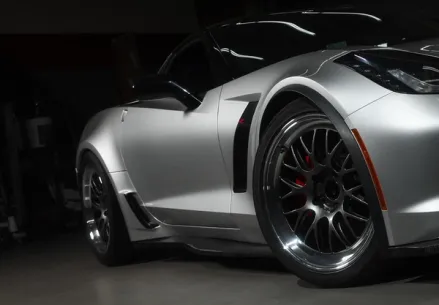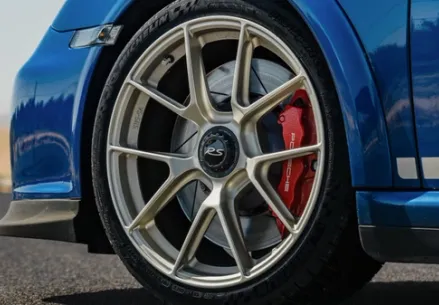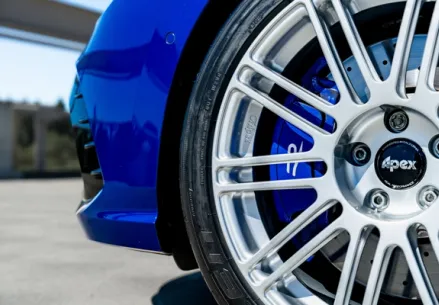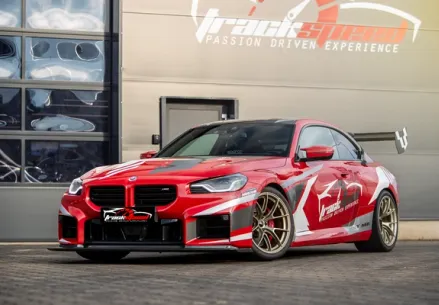
Everything You Need To Know About Reverse Staggered Wheel & Tire Fitments
Article | 09/30/2021 by Geirsen Kalhagen
Updated on 08/06/2024
If you take a stroll through the paddock during an ongoing HPDE, you’ll notice that most of the cars will be running a square setup, with the same size wheels and tires at all four corners. Square setups are quite common for track use, as they allow you to rotate your wheels and tires to maximize tread life, while providing you with a neutral handling balance at the limit. Some RWD cars run staggered setups, where the rear wheels and tires are wider than the front, providing extra grip to the drive wheels. But for an AWD or FWD car, a square setup is typically the most practical option for a variety of HPDE applications.
With that said, many FWD enthusiasts overlook the benefits of running a reverse staggered setup (RSS), which utilizes a wider wheel/tire up front and a narrower wheel/tire in the rear. One could see how an RSS could be viewed as a lesser alternative to a square setup, as you would be running a slimmer tire on two corners, which can result in reduced overall grip. While this claim is mostly accurate taken at face value, it doesn’t quite paint the whole picture as to how advantageous a RSS can be with the right tuning setup and driver know-how.
To help us better understand the ins and outs of running an RSS, we sat down with Easthood Racing’s lead driver, Brian Smith, to discuss the topic in greater detail.

For those who are not familiar, Brian currently drives his MK7 GTI race car in a variety of competitive events across North America, such as Global Time Attack, GRIDLIFE, and the Canadian Sports Compact Series (CSCS). For the 2021 racing season, Brian is running our all-new APEX SM-10 VW wheels in a reverse staggered configuration, with an 18×9” ET42 front wrapped in 265/35-18 tires, and an 18×8.5” ET43 rear with 245/40-18 tires.
From a driving characteristics standpoint, what is the main appeal of a reverse stagger setup compared to a more traditional square setup?
“The main appeal of a reverse stagger setup for me is the on-edge feel the car can give you. Also, there is something to be said about making a change to your car for the sole purpose of speed.
When I make changes that are 100% track-focused, I remember those differences/changes in my head when I drive, which helps me push myself and the car harder knowing ‘I set it up to do THIS.’
From a technical standpoint, having a larger front wheel and tire setup allows the front of the vehicle to have all the grip needed to pull the car along while having a lighter rear end. Less weight on the rear will invite a higher rotational rate as the balance has changed.
Think about mountain biking, if you put more weight over the front wheel and turn, that rear gets extra light and can whip around extra fast.
It’s super exhilarating when you throw a car with an RSS into a corner and you feel the rear just float through the corner and keep up with you on exit. That initial turn is so fast it can really catch you off guard if you aren’t used to it.”
In a non-competitive situation, what setup would you say is more fun to drive at the limit? (reverse stagger or square)
“In a non-competitive situation, a square setup is more fun for sure. Mainly because you have that stability that lets you just have fun. Four-wheel power sliding is so fun! When you max a square setup it’s a great feeling you can replicate lap after lap so typical track days become a blast.”
Are there any specific tracks where you would absolutely want to run a reverse stagger setup as opposed to a square setup?
“Yes! A great example is Pineview Run in NY. Lots of late apex corners, short straights, and it’s basically all curves. It’s a death trap for a FWD car so having that extra rotational ability is a necessity.
Toronto Motorsports Park in Canada is another one. It’s a fast track with some very fast corners that you need to hustle through. It’s also flat so there won’t be any help from natural cambered corners to help keep the speed up.
For my Auto-X people, it’s kinda like the unspoken cheat code if your rules allow it. That rotation is super important.”
Are there any specific tracks where you would absolutely NOT want to run a reverse stagger setup and would opt for a square setup instead?
“I struggled with this one. Technically I should be able to get the best out of whatever setup I’m running, but two tracks where I prefer square are Mid-Ohio Sports Car Course and NYST (New York Safety Track).
Both of these tracks have great sweeping corners, elevation changes, and multiple lines with various cambered corners, meaning the car is pretty much on edge for the whole lap, pushing or not. For me, I feel more comfortable with the square setups as I can really lean on those rear tires to hold when pushing through the corner. Also, the stability at high speed is just wonderful. When you are pushing over 125mph you really feel the change in the car with a RSS, things get a bit twitchy, so I personally feel more comfortable with square.
With that said. For a 1-3 lap “attack session” a RSS can be faster if the confidence is there, I just wouldn’t want to have to drive like that for a 20 min session for a track day.”
What would be your least favorite driving characteristics when running a reverse stagger setup?
“Hmmm, this is hard, only because it’s something that technically can get dialed out with setup changes. But for me, it’s the twitchiness on high-speed straights. I legitimately feel the car get lighter in the rear the faster I go (which is the point). So you know that your turn-in point has to be spot on every time. It’s NOT fun on the highway. Most highways have some camber for rain run-off, so I find myself having to correct the car a lot and you can feel the car get very light in the rear when making transitions.”
When prepping your car for a racing event, what suspension, aero, or other fine-tuning adjustments do you make to better support a reverse stagger setup?
“Sorting out camber is the biggest thing for me. With a lighter rear I need to check how the tires wear in the front and if any hotspots are. Typically I reset everything to my ‘neutral setup.’ Wing AOA is 0, front camber goes to -1.5, and I generally leave my dampening alone. I want to get a good gauge of how the tires react to the surface, temperature, and general track feel. I adjust from there.”
What suspension, aero, or other fine-tuning adjustments do you make to better support a square setup?
“Square I have pretty well set. I set my tire pressures and just get out there and see what I find. As long as they are in good standing I treat it like any other day.” Have you or anyone else on the EHR team experimented with running reverse stagger setups on AWD platforms? If so, how does the driving experience differ from a FWD car with the same setup?
“I have not done that yet but I intend to! Just to see what happens. I don’t imagine there is going to be much of a benefit just due to the weight of AWD vehicles and their nature. However, I don’t know for sure! I’ll let you know what I find out!”
If you would like to learn more about Easthood Racing, you can find their website and social media accounts via the following links:
Main Website: https://www.easthoodracing.com/ Youtube: https://www.youtube.com/easthoodracing Facebook: https://www.facebook.com/EastHoodRacing44/ Instagram: https://www.instagram.com/easthoodracing
If you are interested in running a reverse staggered setup on your MK7, here are our SM-10 fitment recommendations for both 17” and 18” diameters:
Front: 17×9″ ET42 with 255/40-17 tires Rear: 17×8.5″ ET43 with 235/45-17 tires • Front negative camber required.
Front: 18×9″ ET42 with 265/35-18 tires Rear: 18×8.5″ ET43 with 245/40-18 tires • 235/40-18 rear tire can also work. • Front negative camber required.
Photo credits: Thoms Visuals
Tags
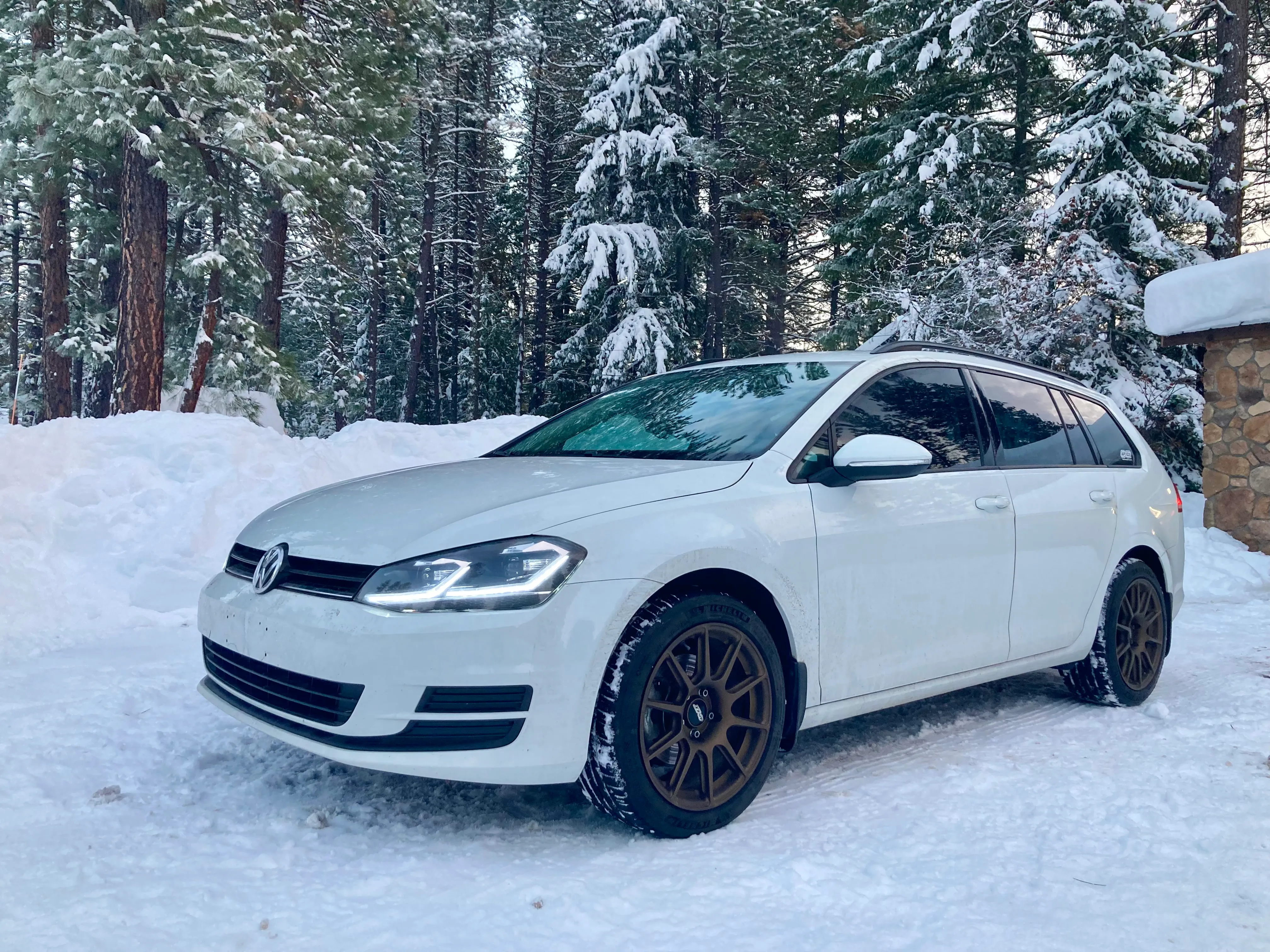 Geirsen Kalhagen
Geirsen KalhagenGeirsen K.
Geirsen (pronounced “gear-sen”) has been a Product Expert at APEX Wheels for more than four years, specializing in VW/Audi and BMW wheel fitments. Prior to joining APEX, he worked for five years in various roles at a BMW dealership, including detailing, service, and BMW Genius. During this time he participated in multiple, corporate training classes in the technical and motorsport aspects of new BMW models. The first car he ever purchased, at the ripe old age of 17, was an E46 325i sedan. That car introduced him to the automotive enthusiast world and instilled a passion for driving that has continued to grow ever since. More recent rides include a Z4M coupe and a 2011 335i, both of which allowed him to further expand his driving skills at HPDEs. Fun Fact: After picking up a Tacoma in his home state of Washington, Geirsen now tows his boat to the river more often than he tows a car to the track.
Have questions about wheels for your VW/Audi, or BMW? Use our contact form and ask for Geirsen.
If you like cheap gear you will hate this newsletter.










